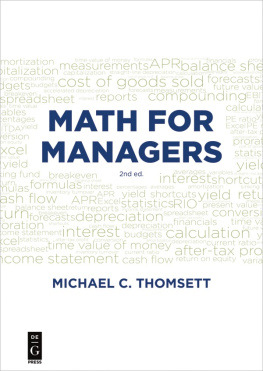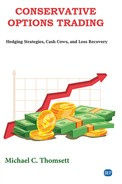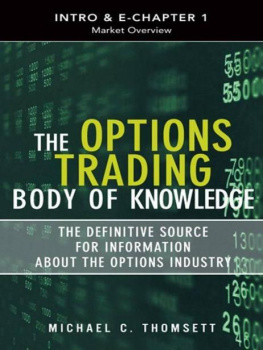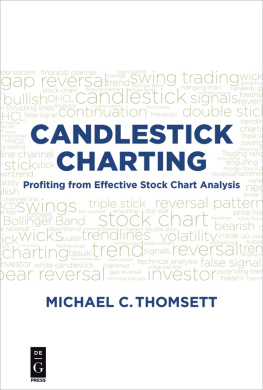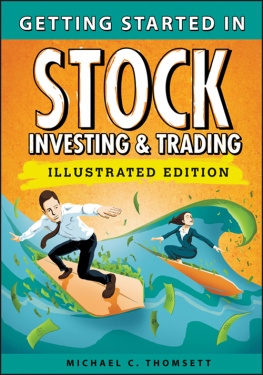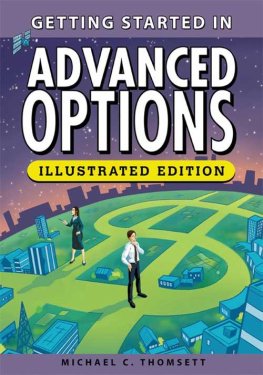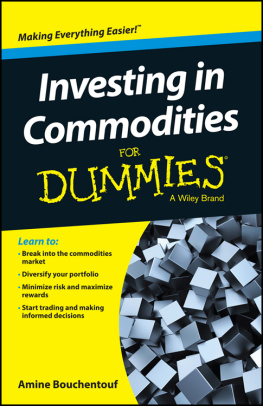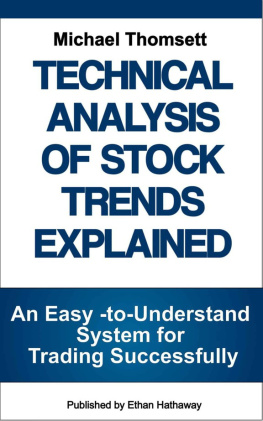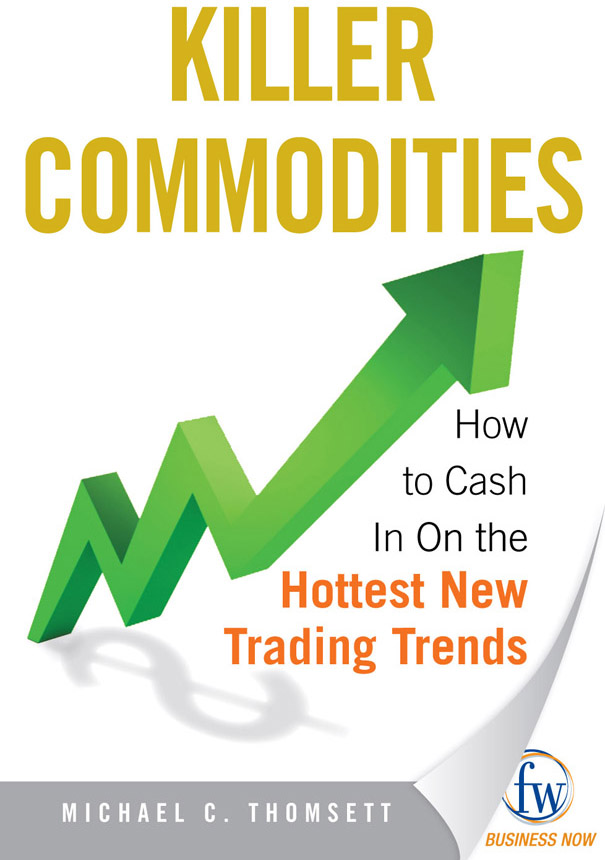
Contents
Commodities: Investing and Trading Solutions for a New Century
The Birth of the U.S. Commodity Market
Commodity Basics
Establishing Market Values
The Profit Potential of Options on Futures
The Commodity Solution to a Falling Dollar
The Energy Plan: Hot Commodity Plays in the Energy Sector
Precious Metals: The Amazing Ascent of Gold, Silver, and More
A Food Fight: Growing Demand for Food Equals Expansion of Commodity Profits
Luxury Food: More Demand in the Specialized Food Products Market
Trading Strategies: The ETF and Index Solution
The Demands of the Future on an Ever-Growing World
Introduction
Commodities: Investing and Trading Solutions for a New Century
In ancient Sumerian trade, baked clay tokens representing sheep and goats were used as a method of trading one set of goods for another. These tokens were used as a promise to deliver the animals at a fixed price in the future. This early form of currency made markets efficient. The problem with this approach was getting it to a point where everyone could agree on value uniformly. This led to standardization of prices and values in trade.
This was an early form of what is today called the commodity market. The commodity market is where commodities (products exchanged among producers and consumers) are exchanged through standardized contracts; prices in the immediate future are fixed by supply and demand. In modern times, this method of trading is essential to maintain an orderly market. Because agricultural products require an entire season from the planting of crops to harvest and marketing, farmers needed to know in advance what they would be paid. And so the commodity futures contract was created to fix the price of goods. Today, this applies far beyond agriculture and is used for the sale of a broad range of products: energy, precious metals, lumber, and even currency, for example.
Todays commodity market is large, complex and fast-moving. Methods of trade include not only direct purchase or sale of futures contracts, but also the use of options, or diversified trading through exchange-traded funds (ETFs) or commodity-based indexes. This book describes the basics of commodities and how they work, and explains the most prominent classes of commodities. It also provides strategic suggestions for the use of ETFs and index vehicles, as well as trading not through futures contracts, but with options on those contracts.
Essentially, a commodity investment involves an estimate of future values. It contains a specific number of products within each contract, a fixed price, and a future date. If you buy a contract (or buy a fund which in turn invests in a series of such contracts), and the actual market price ends up being much higher, your commodity contract will gain value. If the actual market price is lower, the contract loses value. This is the basic cause and effect of commodities: A contract fixes the price, but that contracts value is ultimately determined by how actual prices change in the future. So commodities bring order and certainty to producers (farmers, miners, and ranchers, for example) but they also have created a market for speculation in future prices based on the purchase and sale of contracts.
In this book, you are introduced to a series of basic facts and details of the market at large, and you will find valuable information about how to better understand the major commodity sectors. This approach provides you with a basic and working knowledge of this exciting and fast-moving market.
Chapter 1
The Birth of the U.S. Commodity Market
If you had some way to know in advance what something will be worth several months from now, you would be able to make a killing in the market. Most investors, not having such knowledge, have to guess where stock prices will move in the future. But when it comes to commodities, the future is what its all about. The commodity market sets prices for the future, and those prices rise and fall based on market forces of supply and demand.
For investors and speculators, trading a commodity futures contract is one way to be a player in this lucrative market. Future prices of commodities are estimated and fixed by price and month, then those contracts rise or fall in value based on actual prevailing prices and how they change. The complexity of the market lies in that you can buy or sell (take a long or short position on) futures contracts, trade them directly or through an index or ETF, or use options to control contracts without actually buying or selling them.
How the Modern Commodity Market Started
In the 1800s, the Midwest was the center of commerce in the U.S. The country was predominantly agricultural. In fact, a majority of people lived in small towns or on farms, and most had never traveled more than twenty miles from their birthplace. Given todays mobility, it is amazing how much the country has changed. So has commerce.
The finances involved in the movement of crops and animals, from farm or ranch through centers and rail yards and finally to the consumer, was the dominating economic force in the U.S. The farmers and ranchers of the 19th century needed an orderly exchange market. The time between investment in products and their move to markets was considerable. The forward contract became a standard device for setting the price of goods to be delivered by a fixed date in the future.
In 1848 the first commodity exchange was opened. The Chicago Board of Trade (CBOT) formalized the exchange of forward contracts until 1865, when the standardized futures contract came into effect at the CBOT. Chicago was always a logical center for commodity trading, due to its central geographical location, as well as access through the Great Lakes to the Erie Canal and the Atlantic Ocean. Several other exchanges opened to manage futures regionally by the end of the 19th century. In 1882, the New York Mercantile Exchange (NYMEX) was formed. In 1898, the Chicago Mercantile Exchange (CME) was founded. Along with the Commodity Exchange (COMEX), a subsidiary of NYMEX, they have remained the major U.S. exchanges to this day.
All commodity trading is characterized by risk. In the past, as long as price levels remained stable, there was nothing to worry about. But a drought, insect infestation, financial-market panic, or sudden and unexpected changes in demand could drastically affect prices. The market operated quite well even during times of price surprises. It was not until 1922 that the self-regulatory nature of commodities was changed. In that year, Congress enacted the Grain Futures Act in an attempt to control falling prices after World War I. The new law required public disclosure and licensing of commodity exchanges and their members. Proposed revisions inspired the Commodities Exchange Act of 1936, which was based on a belief that federal oversight would prevent abuse. That act created the Commodity Exchange Authority (CEA) as part of the Department of Agriculture. The CEA was authorized to provide oversight of the industry and when necessary, to bring charges in cases of price manipulation. This system, focused primarily on agricultural goods and livestock, remained the driving force of this market until the 1970s.
This law was superseded in 1974 by the Commodity Futures Trading Commission Act, which included authorization of the Commodity Futures Trading Commission, the major new federal regulatory agency. Around that time, the first nonagricultural-based futures were introduced in the form of financial futures (on interest rates and currency exchange). More regulation followed, including the Futures Trading Act of 1982 which authorized option trading on agricultural commodities. In 2000, Congress passed the Commodity Futures Modernization Act, authorizing trading in single stock futures. The industry has been heavily regulated for decades. However, increasingly, trading in commodities takes place through ETF and index strategies rather than in buying or selling futures contracts directly.



